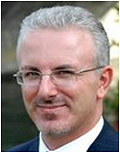Daniele Alfonso & Fabrizio Rovati (STMElectronics)
 | Daniele Alfonso received a MS degree in Electronic Engineering from the Polytechnic of Turin in 1998 and then he joined the Advanced System Technology Labs of STMicroelectronics, working on digital still image compression jointly with the Research Institute for Telecommunications and Information Engineering of the Italian National Research Council. He then moved to Milan area to work on digital video coding standards of the MPEG/ITU-T family and motion-compensated scan-rate conversion. He currently leads a team of research engineers dedicated to development of software and hardware solutions in the field of video coding and video processing for next generation multimedia products, as well as long-term research explorations in innovative multimedia applications. He authored or co-authored about 30 technical publications, including articles, conference papers and standardization contributions to MPEG, ITU-T, DVB and DLNA and he holds several patents granted in Europe and US. |
 | Fabrizio S. Rovati is leading the Networked Multimedia R&D Activities within Advanced System Technology, ST corporate system R&D group. He has a 15 years experience in video coding/decoding and streaming technologies and related applications. He holds 16 granted EU and US patents, and many publications on technical IEEE journals and conferences. He has been contract professor at Pavia Polytechnic University. |
Abstract
| H.264/AVC and VP8 performance analysis for consumer videoconference applications
In this contribution we compare the performance of H.264/AVC and VP8 video coding formats for consumer videoconference applications for mobile or consumer terminals. For the H.264/AVC format we chose the popular x264 open source implementation of the standard, whereas for VP8 we used the libvpx software model that Google open sourced to the web community in May 2010. Since videoconference is strictly a low-delay application, both encoders were similarly configured avoiding backward temporal prediction that would introduce a structural delay in the encoding-decoding chain, and they were also set in constant bit-rate mode, using single-pass bit-rate control with target bit-rates between 512 kb/s and 8 Mb/s, constraining the allowed delay between 125 ms and 500 ms by properly limiting the maximum output buffer capacity.
text continued at upper right hand corner ► |
